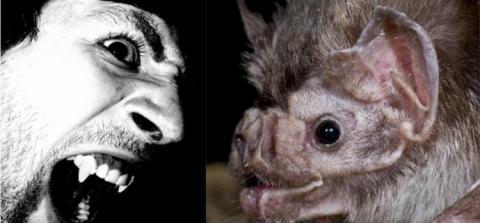Werewolves, ghosts, and vampires—with the days getting shorter and colder, and Halloween fast approaching, our imaginations turn to the ghouls that supposedly come out around this time of year. Vampires, one of history’s most popular monsters, are portrayed in many stories as evil, bloodsucking fiends. However, new scientific research on the real-life vampires of the animal kingdom, Desmodus rotundus, the vampire bat, may reveal a gentler side to these creatures.
In a recent PLOS ONE study, scientists tried to understand the reason social grooming may be more common in vampire bats by observing this behavior across five different bat species. Social grooming usually entails one bat chewing or licking another bat’s body. By observing bats in captivity, as the authors did here, factors that might vary in the wild, such as daylight hours, weather, and interaction with humans, were the same for all bat species in the experiment. In addition, all bats were free from parasitic mites: the absence of parasitic mites is important to ensure a controlled experiment, as the presence of mites is sometimes tied to social grooming.
In the study, the authors observed 127 bats and recorded their behavior, if any, toward other bats of the same species. Researchers noted any instances of social grooming, self-grooming, feeding, or aggression every 10 seconds for 10 minute periods.
The authors found that under similar living conditions and in the absence of parasitic mites, vampire bats spent 14 times longer grooming each other than other bat species. The image shown below is a plot of the incidence of social grooming in the five species of bat studied. Previous research has shown that the presence of more parasites does not necessarily predict more time spent social grooming in vampire bats, so the authors argue that the high level of social grooming that they observed may separate vampire bats behaviorally from other species.

According to the authors, vampire bats’ tendency to spend time grooming one another may be explained by their unique feeding habits. Vampire bats are the only bat species that practice regurgitated food sharing. The reason for this may be to help with group survival. One meal of blood from a bird or mammal is usually large enough to share, but 20% of vampire bats don’t find a meal each night. As vampire bats can only survive three days before starving, food sharing allows bats to help each other out.
The authors also suggest that social grooming may be used to maintain social bonds that may make vampire bats more likely to share food with each other. It could also be a way for bats to say “hello,” or to indicate that they want to receive food from another bat, or that they are willing to share it. In light of these findings, it may be time for us to change our perceptions of these so-called “monsters.” While it’s true that vampire bats have fangs and suck blood, they may also be more likely than other bats to snuggle up to a friend and share a meal.
For more good reads about bats, check out this post about bat flight on the EveryONE blog.
Citation: Carter G, Leffer L (2015) Social Grooming in Bats: Are Vampire Bats Exceptional? PLoS ONE 10(10): e0138430. doi:10.1371/journal.pone.0138430
About the author: Marianne has been a Publications Assistant for PLOS ONE since April of 2014.


Spread the word